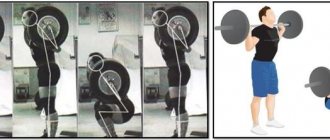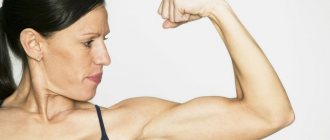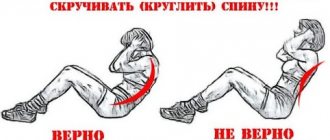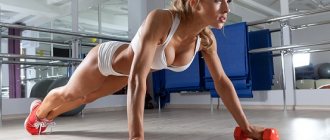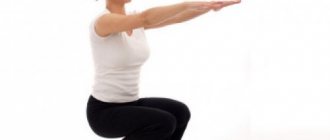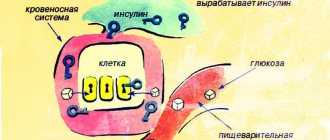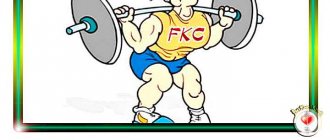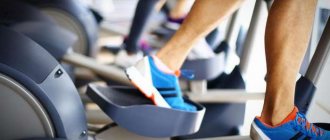Back training in the gym: basic rules
- During a workout aimed at burning fat, perform each exercise for 12-15 repetitions in 3 sets.
- Beginners should start exercising with minimal weights, gradually increasing the load. Choose light dumbbells and an empty bar for the first 1-2 weeks of training.
- Focus on learning the exercise technique and only then move on to increasing the load.
- When you realize that you can easily perform 15 repetitions with minimal weight, move on to more.
- If the goal of training is to increase muscle mass and not lose weight, then perform exercises of 8-12 repetitions in 3-5 approaches.
- Train your back in the gym regularly; for beginners, 2-3 workouts per week is enough.
- Try to minimally strain your biceps: your back should be tense during exercises.
- Hold the weight for a second during peak muscle contraction.
- During exercises, always keep your back straight, do not round or bend it, otherwise there is a risk of injury.
https://youtu.be/vzljZHMKaf4
Great mood
Trainers in gyms are divided into two types. Some people think that they have achieved everything in this life - their biceps are good even without synthol, and their chests are stretching their T-shirt so much that it is about to burst. Such guys walk past exercise equipment with the faces of Nobel laureates, but you shouldn’t sign up with these arrogant characters: they can only support conversations about hardware, and they will conduct a dialogue with the most snobbish look.
You need to choose those trainers who do not participate in the competition for the most difficult cabbage soup in the room. It’s really comfortable to talk with them between approaches: you can chat about nothing, ask questions like “How did you get so pumped up?”, set tasks (“When will I squeeze out a hundred?”) and stare at the fit girls together.
This is much more fun than standing with a sullen expression and silently waiting for the stopwatch to count down the allotted minutes of rest. Therefore, if you choose a great trainer, visiting the rocking chair will always bring joy - even when you drag yourself to the gym without mood or motivation.
* – this is nonsense, such a survey has never happened.
Other texts by Pavel Gorodnitsky:
“Only freaks get to the point of someone like Tereshin. He's trashy." Who tore a sintolist in arm wrestling
“They killed me in my yard.” Rapper Karandash talks about football, basketball, sneakers and a difficult childhood
The best sports telegram
Body-building
British twins have built perfect bodies. Their abs motivate them to quit the bun and run to the gym.
05/15/2020 At 16:04
Body-building
Warm-up before back training in the gym
Start your warm-up with some exercise on the machine. The wide-grip vertical block row to the chest warms up the latissimus dorsi muscles well. Start warming up with minimal weight, and every 2 approaches gradually increase the load to understand what weight is suitable for you during the workout itself.
How to brush your teeth correctly: the secrets of a beautiful smile
Stand in a classic plank position for at least 30 seconds: this exercise is perfect not only for warming up, but also for finishing your workout. Bend your elbows and lean them on the floor, also create support with your toes. Keep your body straight, don't bend, and look straight ahead.
Execution technique
Initial position:
- If possible, adjust your stride length depending on your height (see below for how to choose your stride length)
- Holding the stationary handrail, stand on the pedals of the exercise machine.
- Give your body a vertical position and straighten your back.
- Place your hands on the moving arms of the machine. This will be your starting position.
- Place your feet firmly on the pedals of the exercise machine.
Movement:
- Start the movement: push forward with your leading leg while pulling the handlebar towards you with your opposite hand.
- Immediately after this, without stopping, perform a similar movement on the second leg, using the opposite hand.
- In the final part of the training session, slow down the pace of movement, switching to walking.
- Finish your session on the elliptical trainer and, holding the stationary handrail, step off the steps of the machine.
Attention!
Recommendations!
Exercise options on the elliptical trainer
Back muscle training in the gym
The back muscles are the largest muscle group in the upper body. Developed back muscles visually enlarge the athlete’s body, making the shoulders wider and the waist narrower. This muscle group is the main one for building a V-shaped body, which is the main aesthetic component in an athlete’s body.
The back muscles can be roughly divided into 3 muscle sections:
- Trapezius muscles. They include the muscle section connecting the shoulder to the neck (commonly called the trapezius), as well as the muscles of the central upper back (along the spine from the neck to the lower back).
Latissimus muscles. The largest section of the spinal muscles. Developed lats contribute to the growth of the back in width, and also narrow the waist against the background of this width.
Lumbar muscles. Training this spinal region contributes to the development of a strong and reliable frame for the vertebrae. A developed muscular frame will create good protection against back injury.
We figured out the muscle departments. All that remains is to decide on the training. How to train your back? What is back muscle training in the gym?
First day of training: where to start for a beginner
Not all girls know what beginners should do in the gym. They don’t understand which machine to use, what exercises to start with, how many to do, etc. You need to act according to this plan:
- First you need to choose a gym. Agree with the administration about a free trial session. Look at the set of exercise equipment, their condition, the number of visitors, the cleanliness of the gym, locker rooms, etc.
- Determine the main goal of training: losing weight, building muscle mass, drawing relief, increasing strength and endurance.
- Even if a beginner girl plans to conduct classes in the gym without a trainer, at first she needs the help of a specialist. Therefore, it is recommended to conduct an introductory training with a trainer who will tell you what exercise equipment to pay attention to, what exercises to perform and how to do it correctly.
- Take a towel with you.
- Do not borrow equipment during the pause between sets and ask permission from other athletes to borrow it.
- After use, put the sports equipment back in its place.
- If you don't know how to use the machine, ask a trainer or a more experienced bodybuilder.
- Keep to your gym schedule.
It is better for a girl to start with simple exercises with light dumbbells, kettlebells, a barbell, a fitball, and an elastic band. This equipment will help you strengthen your muscles so you can move on to more complex workouts.
Attention! Do not forget to consult your doctor before exercising in the gym to determine if there are any contraindications. If they are, the doctor will tell you which exercises you need to avoid.
Deadlift (Basic exercise)
The deadlift is the main basic exercise for training the back muscles. The main emphasis of the exercise is aimed at developing the lumbar region of the back. This type of exercise, together with the squat with a barbell, is the standard in bodybuilding, i.e. the most effective for overall muscle growth due to the promotion of greater release of its own (endogenous) testosterone.
- To perform the exercise, we will need a barbell and, if the working weight is large enough for you, safety elements in the form of a waist belt and garters on the wrist.
- It is imperative to learn how to perform the exercise efficiently for greater efficiency and less risk of injury. Until you fully master the technique of performing the exercise, we do not advise you to increase the weight. The mechanics of execution consist of lifting from the floor/lowering the barbell in a vertical plane from a squat position. You need to start the exercise by positioning yourself at the barbell: take the barbell shoulder-width apart, take a semi-squat position and keep your spine straight, slightly arching your back back. Afterwards, we gradually begin to lift the bar off the floor until the legs are fully extended. The moment when the legs are extended is the highest point of the exercise. The back at this moment should be arched slightly back from the plane of the body position. Then we begin to gradually, constantly keeping the spine straight, lower the barbell down, moving it along the legs, almost until it completely touches the floor. (When you work with a light weight, it is optimal not to bring the barbell to full contact with the floor. However, when the weight is large enough, a slight touch with a kick is allowed) This position is the lowest point of the exercise. At the bottom point, you are also in a half-squat position, your spine is straight (your back is slightly arched). Then we repeat the cycle. At the end of the exercise, lower the barbell to the floor (a gradual lowering with a straight back is also necessary). While performing the exercises, be as concentrated as possible, do not let yourself relax for a second until the end of the approach. Any slackening or loss of concentration increases the risk of injury.
The exercise consists of 2-3 warm-up approaches and 3 working approaches. Warm-up approaches are done with light weights. The weight of the apparatus in the warm-up approaches gradually approaches the weight in the working approach, preparing the muscles and joints for maximum loads. Number of repetitions in warm-up and working approaches: 6-8.
For a visual representation of how to perform the exercise correctly, watch the video below:
Deadlift. Classic style.
Who needs instructor help?
Every person’s body has individual characteristics that should be taken into account during the training process. The final result and selection of exercises are influenced by the age and weight of the practitioner, the presence of chronic diseases, as well as the general state of health.
A personal trainer will be needed in the following situations:
- poor sports training;
- saving time;
- recovery from serious injuries;
- health problems, including obesity;
- pregnancy and postpartum recovery;
- professional sports;
- figure correction;
- lack of skills in the sports field;
- children visiting the gym in order to straighten their posture, as well as get rid of a sedentary lifestyle;
- infant swimming;
- fitness classes for older people;
- negative training experience in the past;
- shyness and lack of self-confidence;
- assistance in mastering simulators and exercise techniques.
Tips from a professional are necessary for everyone who strives for high results without negative consequences for the body.
Don't miss the most popular article in the section: Body drying for girls. Training program, detailed nutrition menu for the month by day.
Pull-ups
If you want to make your back wider and more massive, then you need to take care of the development of the latissimus dorsi muscles. An exercise such as pull-ups will help you achieve this goal very well. Pull-ups are one of the most important exercises for developing the latissimus dorsi muscles.
- To perform the exercise, we will need a horizontal bar and, if pulling up with your own weight is not difficult for you, weights with a special belt for hanging these same weights on the body.
- The mechanics of the exercise is to perform lifting/lowering of the body on the crossbar (horizontal bar). You need to grab the bar as wide as possible. At the bottom point, you hang on the horizontal bar with your arms fully extended. At the top point, you swing on the horizontal bar with your arms bent to 90-120 degrees. As you do this, you evenly lift your body up as if you were pulling your pectoral muscles toward the bar. There is no need to throw your chin, it is enough to bring your pecs as close as possible to the bar.
The exercise either consists of 1 warm-up approach (if working approaches are performed with weights) and 3 working sets. Or 3 workers at once (if you do them with your own weight).
For a visual representation of how to perform the exercise correctly, watch the video below:
Pull-up technique on the horizontal bar.
https://youtu.be/eMsTT1uajTY
The most effective exercise machine for weight loss
You won't find the perfect trainer that suits everyone. Everyone has their own individual problems with excess weight. Each muscle group has its own techniques. A trainer at a fitness center can best tell you which ones. It will help you not only choose the optimal exercise machine for weight loss, but also create a balanced diet and choose the appropriate exercises.
Vertical block thrust
The vertical pull-down is an exercise whose mechanics are very similar to pull-ups. If you find it difficult to do pull-ups with your own weight, then it is better to replace them with vertical pull-downs. If you want to thoroughly refine (finish off) your lats, then you can also turn to this exercise. The vertical block row allows you to slightly isolate the auxiliary muscles, thereby concentrating the load on the target ones.
- To perform the exercise, we will need a special simulator for block rows. Install the required handle on the upper mount of the machine. Adjust the foot rest to a comfortable height so that it presses your feet firmly against the floor. After installing the necessary weights on the simulator, you can begin to perform.
- The mechanics of performing the exercise consist of lowering/raising the handle in a vertical plane. The exercise is performed in a similar way to pull-ups. The handle is pulled towards the chest. At the top point, the handle is at the top, the arms are extended. At the bottom there is a handle below at chest level, the body is tilted slightly back. Lowering/raising the handle is carried out in front of the head.
The exercise consists of 1 warm-up approach and 3 working sets. The warm-up approach is done with 60-70% of the working weight. Number of repetitions in warm-up and working approaches: 8-10.
For a visual representation of how to perform the exercise correctly, watch the video below:
It's a lat pulldown, baby!
Bent-over one-arm dumbbell row
The one-arm dumbbell row is an exercise aimed at developing the latissimus dorsi muscles.
- To perform the exercise, we will need any bench (or some other object) on which we can, fixed in an inclination, perform the exercise, as well as a dumbbell as a weighting agent. Before performing it, you need to take a comfortable position: lean on the bench with your hand, lean on the bench with one leg - on the same side as the resting hand, if required by the desire to maintain balance, the back is arched. Once you have taken the correct position, you can begin to perform.
- The mechanics of performing the exercise is to raise/lower the dumbbell in a vertical plane. At the lowest point, the dumbbell is at arm's length below, the target back muscle is stretched to its maximum. At the top - a dumbbell at the top at rib level, the target back muscle is contracted as much as possible. The exercise must be performed with a constantly arched back.
The exercise consists of 1 warm-up approach and 3 working sets. The warm-up approach is done with 60-70% of the working weight. Number of repetitions in warm-up and working approaches: 8-10.
For a visual representation of how to perform the exercise correctly, watch the video below:
Exercises for the back. Bent-over dumbbell row.
https://youtu.be/Ch4UZW_j08Q
How to choose a stepper training program
With the help of a stepper you can both lose weight and pump up your buttocks. To achieve a slim and beautiful body, you need to choose the right training program, or even better, alternate them.
Weight loss program
A half-hour workout on a stepper burns about 300–500 calories. If you want to lose weight using only this machine, then you should train for at least an hour.
- We start with a calm five-minute walk with our arms bent at the elbows.
- We speed up the pace and after 4 minutes we switch to a minute run.
- We return to a slow pace and stick to it for 5 minutes.
- We rest for 1 minute.
- We repeat the set of exercises 3 more times.
From the second week we increase the duration of the first and third sessions by five minutes.
By the third week, the entire lesson should last 1 hour.
You will get the first result after two weeks of regular exercise.
When working on a ministepper, do not forget about training your arms. If the exercise machine comes with an expander, then perform the following exercises for 20 repetitions:
- raise our arms to the sides
- raise our hands in front of us
- bend your arms into biceps
You can also use dumbbells to train your arm muscles.
Video: Doing ministepper exercises at home
https://youtu.be/UJExnf3n1-k
Program for training the buttocks and leg muscles
Consider a program for training the gluteal muscles. Before each workout, you need to warm up for 5-10 minutes.
First week:
We perform 50 steps in 1 minute. We rest for the next minute. Now we perform 60 steps per minute. Let's rest for a minute. The next session lasts 2 minutes, but still performs 60 steps. A minute of rest. 50 steps in 2 minutes. Rest.
Second week: Perform 50 steps in 1 minute. We rest for the next minute. Now we perform 60 steps per minute. Let's rest for a minute. The next session lasts 2 minutes, 60 steps are performed. A minute of rest. 50 steps in 1 minute. Rest.
Third week:
We perform 50 steps in 1 minute. We rest for the next minute. Now we perform 65 steps in 2 minutes. Let's rest for a minute. 70 steps in 2 minutes. A minute of rest. 65 steps in 1 minute. Rest. Again 65 steps in 1 minute.
Fourth week:
We perform 60 steps in 3 minutes. A minute of rest. 65 steps in 2 minutes. A minute's rest. 70 steps in 2 minutes. A minute of rest. 70 steps in 2 minutes. Minutes of rest. Another 70 steps in 2 minutes.
Video: Pumping up your buttocks on a stepper
Regular exercise on a stepper will not only allow you to lose weight and gain beautiful shape, but will also improve the functioning of your heart and cardiovascular system. The first results of training can be observed after two weeks of regular walking. If you feel that you have conquered the home stepper, but the desired shape has not yet been achieved, then feel free to sign up for the gym. Starting with larger varieties of steppers, you can gradually move on to other simulators that will help significantly diversify your workouts.
Bent-over barbell row
Bent-over barbell row is an exercise aimed at developing the lumbar muscles and those running along the spine.
- To perform the exercise we will need a barbell rack and the barbell itself. Before performing, you must take the correct body position. It is at a certain position of the body that the target muscles are fully loaded. The first thing you need to do is take the barbell in your hands and straighten up completely. Next, arching our backs, we move the body a little forward - about 45 degrees from the plane of the body, while simultaneously bending slightly at the knees. With this body position, the barbell should hang freely on outstretched arms. Once you have taken the required position, you can begin to perform.
- The mechanics of performing the exercise consist of raising/lowering the barbell along the thigh muscles of the legs. At the lowest point, the arms are extended, the barbell is at the bottom. At the top point the bar is at the level of the pelvis. The exercise must be performed smoothly, without sudden movements, constantly monitoring the barbell.
The exercise consists of 1-2 warm-up approaches and 3 working approaches. Warm-up approaches are done with light weights. The weight of the apparatus in the warm-up approaches gradually approaches the weight in the working approach, preparing the muscles and joints for maximum loads. Number of repetitions in warm-up and working approaches: 6-8.
For a visual representation of how to perform the exercise correctly, watch the video below:
It's the BENT-UP ROW, baby!
Horizontal block pull to the belt
The horizontal block row to the waist is an exercise aimed at developing the lumbar muscles. Performed in a block row machine.
- To perform the exercise, we will need a block pull simulator and a corresponding handle that allows us to place our hands in close proximity to each other. You need to take the following position: put your feet on the footrests, bending your knees slightly, take the handle and lean your back a little. Now you can start execution.
- The mechanics of performing the exercise is to pull the weight towards yourself and back. The handle moves parallel to the floor. The starting point is the handle is as far away from the body as possible, the arms are straightened, the back muscles are stretched as much as possible. End point - the handle is near the stomach, arms are bent. Your back must be kept straight while performing the exercise.
The exercise consists of 1 warm-up approach and 3 working sets. The warm-up approach is done with 60-70% of the working weight. Number of repetitions in warm-up and working approaches: 8-10.
For a visual representation of how to perform the exercise correctly, watch the video below:
Exercises for the back. Lower block thrust.
There are many more exercises for the back, but their effects on muscle groups are similar to the effects of the exercises described above. In order not to create a mess in your head, use this set of exercises to create a training program.
Related definitions
- The segment AB passing through the foci of the ellipse, whose ends lie on the ellipse, is called the major axis
of this ellipse.
The length of the major axis is 2 a
in the above equation. - The segment CD perpendicular to the major axis of the ellipse, passing through the central point of the major axis, the ends of which lie on the ellipse, is called the minor axis
of the ellipse. - The intersection point of the major and minor axes of an ellipse is called its center
. - The segments drawn from the center of the ellipse to the vertices on the major and minor axes are called, respectively, the semimajor axis
and
semiminor axis
of the ellipse, and are designated
a
and
b
. - The distances r 1 {\displaystyle r_{1}} and r 2 {\displaystyle r_{2}} from each focus to a given point on the ellipse are called the focal radii
at that point. - Distance c = | F 1 F 2 | 2 {\displaystyle c={\frac {|F_{1}F_{2}|}{2}}} is called focal length
. - Quantity e = ca = 1 − b 2 a 2 {\displaystyle e={\frac {c}{a}}={\sqrt {1-{\frac {b^{2}}{a^{2}} }}}} is called eccentricity
. - The diameter of
an ellipse is an arbitrary chord passing through its center.
The conjugate
diameters of an ellipse are a pair of its diameters that have the following property: the midpoints of chords parallel to the first diameter lie on the second diameter. In this case, the midpoints of the chords parallel to the second diameter lie on the first diameter. - The radius
of the ellipse at a given point is the segment connecting the center of the ellipse with the point, as well as its length, which is calculated by the formula r = abb 2 cos 2 φ + a 2 sin 2 φ = b 1 − e 2 cos 2 φ {\ displaystyle r={\frac {ab}{\sqrt {b^{2}\cos ^{2}\varphi +a^{2}\sin ^{2}\varphi }}}={\frac {b} {\sqrt {1-e^{2}\cos ^{2}\varphi }}}}, where φ {\displaystyle \varphi } is the angle between the radius and the semimajor axis. - The focal parameter
p = b 2 a {\displaystyle p={\frac {b^{2}}{a}}} is half the length of the chord passing through the focus and perpendicular to the major axis of the ellipse. - The ratio of the lengths of the minor and major semi-axes is called compression ratio
or
ellipticity
: k = ba.
{\displaystyle k={\frac {b}{a}}.} Value equal to ( 1 − k ) = a − ba , {\displaystyle (1-k)={\frac {ab}{a}}, } is called compression
. For a circle, the compression coefficient is equal to one, the compression is zero. The compression ratio and the eccentricity of the ellipse are related by the relation k 2 = 1 − e 2 . {\displaystyle k^{2}=1-e^{2}.} - For each of the foci there is a straight line, called directrix
, such that the ratio of the distance from an arbitrary point of the ellipse to its focus to the distance from this point to this straight line is equal to the eccentricity of the ellipse. The entire ellipse lies on the same side of such a straight line as the focus. The equations of the directrixes of an ellipse in canonical form are written as x = ± pe ( 1 + e ) {\displaystyle x=\pm {\frac {p}{e\left(1+e\right)}}} for foci ( ∓ p 1 + e , 0 ) {\displaystyle \left(\mp {\frac {p}{1+e}},\,0\right)} respectively. The distance between the focus and the directrix is pe. {\displaystyle {\frac {p}{e}}.}
Back exercises - basic and auxiliary
Exercises for the back muscles are an important part of the training program in the gym. To achieve a beautiful and muscular body through bodybuilding, barbell bench presses and biceps curls are not enough. Basic back exercises in the gym will make it wider and thicker - this is the goal of every beginner.
Pull-ups, deadlifts, barbell rows and pull-downs should be an integral part of the program for gaining muscle mass.
Muscles working during back exercises
- trapezius muscle of the back (upper)
- latissimus dorsi (middle)
- rectifiers (bottom)
Exercises for the trapezius muscle
give the back thickness.
Latissimus muscles
widen the upper back, making the waist visually narrower.
Back straighteners
do not make a big difference in appearance, but they help stabilize the back in heavy compound exercises (Back Squats, Deadlifts).
Elliptical trainer for weight loss
An elliptical trainer is a very effective type of sports equipment for losing excess weight. This is a favorite exercise machine for many - working on it is not monotonous, time flies much faster than when running. During training, calories are actively burned, and both the respiratory and vascular systems, the muscles of the legs and buttocks are well strengthened. The effectiveness of such exercise machines is quite comparable to the effectiveness of treadmills, but they are still slightly inferior to them. But exercising on them is much easier and, most importantly, safer for the joints of the legs.
Number of repetitions and sets of back exercises
12-15 reps in 3 sets for each exercise
For beginners
in the gym you need to do at least 12 repetitions with a small weight in order to learn the correct technique, the body remembers the mechanics of the movements. Then gradually increase. For the first time, train without any weights at all or with the lightest dumbbells/empty bar, or at home. At each workout, try to do more repetitions than the last. When you do all 15 repetitions easily, increase the working weights. Such caution is necessary so as not to knock off the little toe on your left foot or other vital parts of the body with a heavy dumbbell.
High-intensity workout for fat burning and muscle cutting
: Lots of reps and little rest to keep your workout intensity high.
6 to 8 reps in 3-5 sets
Mass training. Do more basic back exercises with free weights and low reps.
Optimal schedule: how many times a week and at what time to go to the gym
To get a good result, it is important to develop a system for visiting the gym and conduct classes regularly.
To do this, a novice athlete must understand how many times a week she can visit a fitness club and spend time training along with showering and changing clothes. Girls who have children will be able to devote less time to this than single ladies. The main thing is to answer the question honestly. If it's half an hour, then don't promise yourself to do 4 sets for each muscle group. It is better to train for half an hour three times a week than for 2 hours, but only once. To lose weight and improve your figure, a beginner girl should exercise 2-3 times in 7 days. In this case, it is necessary to take a break between workouts of 1-2 days. It is important to give the body rest and recovery. A novice athlete can spend from 30 to 60 minutes doing the exercises. Rest between sets should be 1 to 2 minutes.
It is also important to understand what time of day to conduct training for beginners in the gym. The optimal time period is from 13 to 16 hours of the day. During this period, the girl’s body becomes the strongest, most resilient, and flexible. In addition, the gym is practically empty at this time. Most people appear from 7 to 9 am, from 18 to 21 pm on weekdays, and from 9 to 16 pm on weekends.
Back muscle training program for weight in the gym
Back exercises are often done on the same day as chest training. Start your workout with your back muscles, as this muscle group is larger. But if your chest muscles are lagging behind, then do them first, when you have more strength.
Basic basic exercises
Pull-ups
video - Pull-ups and barbell rows
Features of the technique:
- by changing the width of the grip, you can work on different areas of the back: the wider the grip, the more the lats are involved in the work, making the back wide;
- pull yourself up using the muscles of your back, not your arms - the biceps are included in the work only at the top point;
- Don't pull your shoulders towards your ears.
If you weigh little and it’s easy to pull yourself up, use a weight – a belt with a weight plate. If, on the contrary, you still can’t pull yourself up, then put the chair down and push off from it with one leg. In the gym, you can do pull-ups on a special “Graviton” simulator (the greater the weight of the counterweight, the easier it is to do pull-ups; start with a counterweight slightly lighter than your own weight).
Deadlift
video - deadlift
The deadlift is the best, but at the same time the most traumatic back exercise. The deadlift is indispensable when working on weight. The main thing is to master the correct technique and not rush to hang more weights on the barbell. To protect yourself from injury: pump up your abdominal muscles and spinal erectors. They will support the spine during the deadlift. Auxiliary exercises: hyperextension, abdominal crunches.
Deadlift Variations:
Bent-over barbell row
video - Bent-over barbell row
Bent-over barbell rows help build mass in the latissimus and trapezius dorsi muscles; this exercise should definitely be included in your mass program. All of the Deadlift tips apply to the Bent Over Row as well - master the technique and strengthen the supporting muscles before adding more weight to the barbell.
Features of the technique:
- legs slightly bent at the knees;
- back at an angle of 45%;
- spine in one straight line;
- pull the barbell to the lower abdomen, not to the chest;
- the bar slides over your thighs.
One-arm dumbbell row
video - one-arm dumbbell row
The one-arm dumbbell row is a great alternative to the bent-over barbell row. Do this exercise longer (first with one hand, then with the other...), but you can work with a greater amplitude (the muscles will stretch and contract stronger). Those. you can only lift the barbell up to your stomach, and pull the dumbbell higher. Due to this, the back muscles are better “pumped”.
Features of the technique:
- back parallel to the bench;
- pull the dumbbell with your back muscles first, the biceps are activated only at the end: you pump your back, not your arms!
- at the top point of the exercise, the body does not need to be turned (the back remains parallel to the bench), it is important to feel the contraction of the back muscles.
T-row on the machine
video - T bar row technique
T-row on the machine works the lats and minimizes the load on the spine
. This is necessary for those who cannot perform basic exercises with free weights due to injuries or want to “finish off” the lats after the basics without overloading the spine.
Upper block pull
video - Technique lat pulldown
The lat pull-down is an auxiliary back exercise for those who do not yet know how to do pull-ups.
Lower block thrust
https://youtu.be/DvraNGVLMss
video - Lower pulley technique
The lower block row is an alternative to the bent-over barbell row; you can put it at the end of the workout to “finish off” the back muscles.
Hyperextension
video - Hyperextension technique
Hyperextension is a great exercise for the spinal erectors. It can be done either with additional weight (barbell or plate) or without.
Features of the technique:
- the hips lie on pillows in front;
- the hip bones are at the leading edge of the pads. If you move your pelvis 10 cm higher, your legs and gluteal muscles will receive more load;
- the back does not round when performing the exercise, it remains straight;
- When rising from the bottom point, the back does not hyperextend; it should be in line with the legs.
If you liked the article, share with your friends!
Exercise equipment for home for weight loss
All exercise equipment can be divided into 2 types: cardio and strength equipment. If you need to strengthen your muscles, choose strength ones; to lose weight you will need cardio equipment . These include an exercise bike, treadmill, stepper, rowing machine, and elliptical trainer.
When choosing a model, pay attention to the performance criteria.
The more muscles the exercise machine uses, the more calories you burn, which means the exercises will be very effective.
Deep active breathing during training indicates good saturation of the body with oxygen, which allows you to quickly burn excess fat.
The stepper is a popular home exercise machine; it is compact, inexpensive and very easy to use. It simulates walking on stairs, allowing you to lose weight step by step. The stepper is sometimes equipped with a step counter, heart rate counter and load adjustment.
It’s easy to train on it, 20 minutes a day and soon you will see the first result. But when exercising, only a small percentage of the muscles work, and breathing is not very deep. Thus, the stepper is not the most effective exercise machine for weight loss.
An exercise bike is a universal exercise bike for losing weight and staying in great shape. With its help, you can strengthen your legs and buttocks, as well as increase the endurance of the respiratory and cardiovascular systems. Training on an exercise bike gives much more serious loads than a stepper. But if you buy it, be aware that you are sitting during training, which means that burning calories will not be as effective.
This exercise machine is perfect for those who do not like intense exercise. But it is not at all suitable for people who have a weak spine. It is better to conduct classes 2 hours after eating.
Rowing simulator. Recently it has become more and more popular. During training, almost all muscle groups are involved, the lungs are ventilated, and there is an active process of burning excess fat. Movements that imitate rowing allow you to stretch muscles and improve the flexibility of the vertebrae, so this exercise machine is very useful for those suffering from osteochondrosis.
The treadmill is an effective exercise machine for weight loss. During training, the maximum number of muscles is involved, breathing becomes deep. A treadmill allows you to diversify your workouts by changing their intensity. The effectiveness of a treadmill machine compared to a stepper and an exercise bike is much higher, but training on it is not at all suitable for the lazy. To lose excess weight, you will have to work hard.
Back exercises - basic and auxiliary
Exercises for the back muscles are an important part of the training program in the gym. To achieve a beautiful and muscular body through bodybuilding, barbell bench presses and biceps curls are not enough. Basic back exercises in the gym will make it wider and thicker - this is the goal of every beginner.
Pull-ups, deadlifts, barbell rows and pull-downs should be an integral part of the program for gaining muscle mass.
Muscles working during back exercises
- trapezius muscle of the back (upper)
- latissimus dorsi (middle)
- rectifiers (bottom)
Exercises for the trapezius muscle
give the back thickness.
Latissimus muscles
widen the upper back, making the waist visually narrower.
Back straighteners
do not make a big difference in appearance, but they help stabilize the back in heavy compound exercises (Back Squats, Deadlifts).
List of popular services of fitness instructors
Experienced professionals provide services in the sports field in the following areas:
| Direction name | a brief description of |
| Gym | With the help of exercises, effective weight loss occurs in combination with training for different muscle groups and proper nutrition. |
| Functional training | Classes are aimed at strengthening muscles and relieving stress from the spine. They can be visited by people of any age. Training does not cause discomfort and does not take much energy. |
| Strength training | Exercises are performed non-stop on different muscles in turn. They develop muscles, make the figure slimmer, and develop endurance, agility and strength. |
| Yoga, Pilates, stretching, fitball exercises, acrobatics | Exercises for body flexibility. Many women visit fitness clubs to achieve a toned figure with good stretching. During training, clients are taught to listen to their own feelings, control the body, correct posture, and work all muscle groups. |
| Body-building | Classes are aimed at achieving an attractive muscle definition and gaining muscle mass. |
| Losing excess weight | The program is designed based on the characteristics of the athlete’s body. Consists of several types of exercise and proper nutrition. |
| Martial arts, which includes boxing, judo, karate, capoeira, taekwondo, kickboxing | These sports combine oriental and international martial arts. Very popular among children. They form discipline, internal and external strength, and coordination of movements. |
| Fitness trainer services at home | Training helps to significantly save time on travel to the gym, eliminates the need to purchase a subscription, and reduces travel costs to the fitness club. Classes are ideal for mothers on maternity leave, shy people, overly busy clients and those who do not like stuffy rooms. |
| EMS training (electrical stimulation) | During exercise, electrical impulses are sent to the muscles through electrodes that are connected to the human body. Such impulses contribute to muscle contraction. The emphasis is placed not so much on physical activity, but on the frequency of impulses of the simulator. |
A personal fitness trainer can help with strength training, bodybuilding, or yoga.
Popular services also include dance aerobics, rehabilitation fitness, swimming pool, fitness for pregnant women, crossfit (circuit training) and some others.
Number of repetitions and sets of back exercises
12-15 reps in 3 sets for each exercise
For beginners
in the gym you need to do at least 12 repetitions with a small weight in order to learn the correct technique, the body remembers the mechanics of the movements. Then gradually increase. For the first time, train without any weights at all or with the lightest dumbbells/empty bar, or at home. At each workout, try to do more repetitions than the last. When you do all 15 repetitions easily, increase the working weights. Such caution is necessary so as not to knock off the little toe on your left foot or other vital parts of the body with a heavy dumbbell.
High-intensity workout for fat burning and muscle cutting
: Lots of reps and little rest to keep your workout intensity high.
6 to 8 reps in 3-5 sets
Mass training. Do more basic back exercises with free weights and low reps.
Back muscle training program for weight in the gym
Back exercises are often done on the same day as chest training. Start your workout with your back muscles, as this muscle group is larger. But if your chest muscles are lagging behind, then do them first, when you have more strength.
Basic basic exercises
Pull-ups
video - Pull-ups and barbell rows
Features of the technique:
- by changing the width of the grip, you can work on different areas of the back: the wider the grip, the more the lats are involved in the work, making the back wide;
- pull yourself up using the muscles of your back, not your arms - the biceps are included in the work only at the top point;
- Don't pull your shoulders towards your ears.
If you weigh little and it’s easy to pull yourself up, use a weight – a belt with a weight plate. If, on the contrary, you still can’t pull yourself up, then put the chair down and push off from it with one leg. In the gym, you can do pull-ups on a special “Graviton” simulator (the greater the weight of the counterweight, the easier it is to do pull-ups; start with a counterweight slightly lighter than your own weight).
Deadlift
video - deadlift
The deadlift is the best, but at the same time the most traumatic back exercise. The deadlift is indispensable when working on weight. The main thing is to master the correct technique and not rush to hang more weights on the barbell. To protect yourself from injury: pump up your abdominal muscles and spinal erectors. They will support the spine during the deadlift. Auxiliary exercises: hyperextension, abdominal crunches.
Deadlift Variations:
Bent-over barbell row
video - Bent-over barbell row
Bent-over barbell rows help build mass in the latissimus and trapezius dorsi muscles; this exercise should definitely be included in your mass program. All of the Deadlift tips apply to the Bent Over Row as well - master the technique and strengthen the supporting muscles before adding more weight to the barbell.
Features of the technique:
- legs slightly bent at the knees;
- back at an angle of 45%;
- spine in one straight line;
- pull the barbell to the lower abdomen, not to the chest;
- the bar slides over your thighs.
One-arm dumbbell row
video - one-arm dumbbell row
The one-arm dumbbell row is a great alternative to the bent-over barbell row. Do this exercise longer (first with one hand, then with the other...), but you can work with a greater amplitude (the muscles will stretch and contract stronger). Those. you can only lift the barbell up to your stomach, and pull the dumbbell higher. Due to this, the back muscles are better “pumped”.
Features of the technique:
- back parallel to the bench;
- pull the dumbbell with your back muscles first, the biceps are activated only at the end: you pump your back, not your arms!
- at the top point of the exercise, the body does not need to be turned (the back remains parallel to the bench), it is important to feel the contraction of the back muscles.
T-row on the machine
video - T bar row technique
T-row on the machine works the lats and minimizes the load on the spine
. This is necessary for those who cannot perform basic exercises with free weights due to injuries or want to “finish off” the lats after the basics without overloading the spine.
Upper block pull
video - Technique lat pulldown
The lat pull-down is an auxiliary back exercise for those who do not yet know how to do pull-ups.
Lower block thrust
video - Lower pull-down technique
The lower block row is an alternative to the bent-over barbell row; you can put it at the end of the workout to “finish off” the back muscles.
Hyperextension
video - Hyperextension technique
Hyperextension is a great exercise for the spinal erectors. It can be done either with additional weight (barbell or plate) or without.
Features of the technique:
- the hips lie on pillows in front;
- the hip bones are at the leading edge of the pads. If you move your pelvis 10 cm higher, your legs and gluteal muscles will receive more load;
- the back does not round when performing the exercise, it remains straight;
- When rising from the bottom point, the back does not hyperextend; it should be in line with the legs.
If you liked the article, share with your friends!
It's time to pull metal.
According to a Eurosport.ru survey, 73% of people starting a new life indicate the “Sign up for a gym” item in their task list*.
There are a million incentives: some need to pump up, some need to lose weight, some need to improve their stamina. The fact is that you can go to the gym without a personal trainer only in one case - if you are a trainer yourself.
Body-building
Gay bodybuilder fell ill with coronavirus and showed off his dramatically deflated body
12 HOURS AGO
Below are 7 proofs that you need a great coach to make tangible progress.
